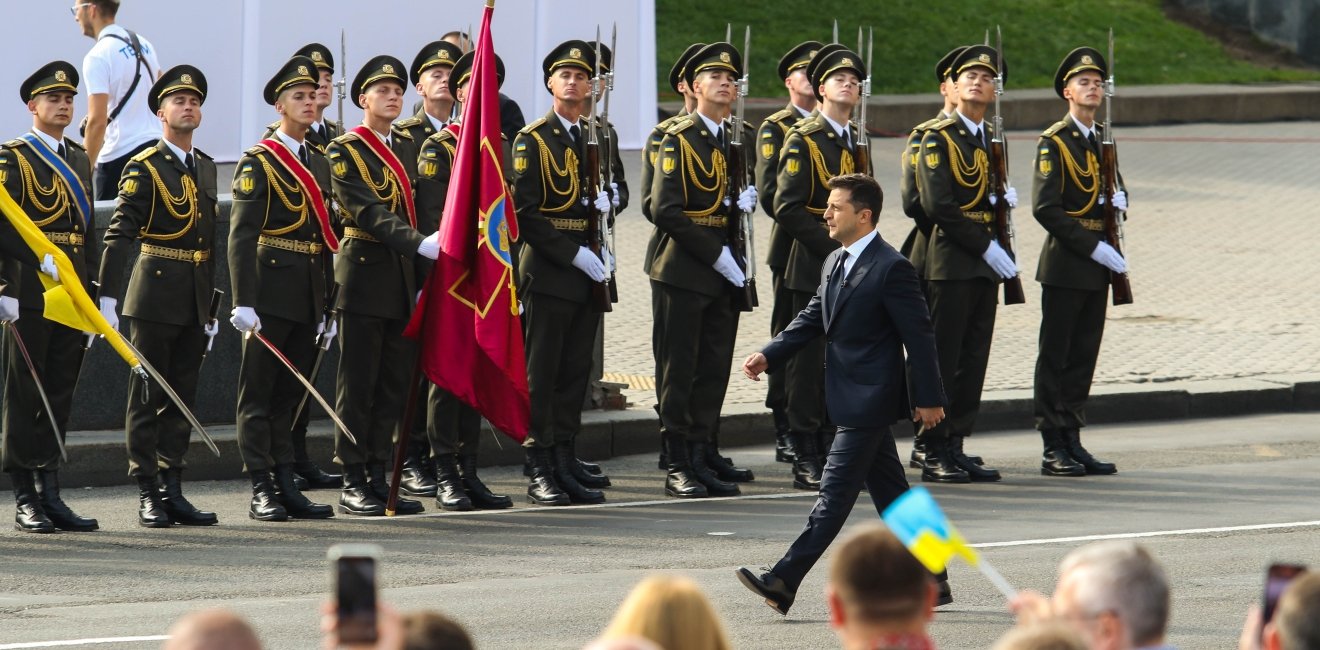
A blog of the Kennan Institute
BY MYKHAILO MINAKOV
Among Ukrainian politicians and analysts there is seemingly an unusual consensus: everyone expects a political tempest this autumn in Kyiv, once lawmakers and politicians return to work after the summer recess. Judging from the public debates over the last two months in Ukraine, there are two reasons to expect turmoil: the changing nature of President Volodymyr Zelensky’s regime and the changing geopolitical context. Both kinds of changes are thought capable of bringing Ukraine to the brink of a political crisis that could see the consolidation of the opposition and more intense social protests.
Zelensky’s political education has been steep and uneven over the past two years, and he has not avoided the strong centralizing tendencies that are characteristic of other post-Soviet states. The next few months will be a test of Zelensky’s political acumen and whether he is flexible enough to turn various domestic and geopolitical problems into opportunities.
A Changing Regime
Notably, the content, form, and style of President Zelensky’s policies have changed dramatically. From a perestroika-style reformist and a populist leader of the new political generation, President Zelensky has fallen back on the traditional agenda of post-Soviet presidents: he has started creating his own “power vertical” that erodes the constitutional system of checks and balances.
Zelensky approaches the November midpoint of his five-year term with some sort of power vertical assembled. A power vertical is a structure that destroys the separation of powers into branches and tiers and establishes a chain of subordination of the executive, the legislature, the judiciary, and local government to the presidential administration. Unlike Ukraine’s previous presidents, Zelensky does not have his own clan, a stable political adopted family, which has resulted in a much lower level of corruption around him. But the unhappy logic of the post-Soviet presidential institution has inevitably led him to need the power vertical formation.
Today the Zelensky administration controls the Verkhovna Rada through a loyal majority of Servants of the People MPs and several allied MP groups. The current Cabinet of Ministers is fully loyal to the president, while the prime minister has shown no personal political program (though formally the prime minister can be a very influential power figure). The Constitutional Court is in continuous crisis owing to its conflict with the president. The judiciary at large is operating at a nadir of efficiency owing to unfinished reforms, endemic corruption, and constant clashes with the executive. Since the recent local elections did not see the Servant of People party establishing effective control over the local councils, the Zelensky administration has begun promoting a semiformal congress of local and regional authorities presided over by the head of the presidential staff. So far the informal presidential control over the formal branches and tiers of power is neither absolute nor efficient. But it is definitely very different from the constitutionally mandated separation of powers and from Zelensky’s policies during his first year office.
The core of the vertical is now vested in the hard power institutions. Since October 2020, the Security Council has become the center of decision-making in Ukraine. In less than a year, the council has already sanctioned—bypassing court procedures to do so—Constitutional Court judges, several oligarchs, many criminals, and some opposition (mainly Russia-leaning) leaders and their businesses and media outlets. In July and August the presidential team increased control over the Ministry of Interior and key positions in the Ukrainian Army. With the resignation of former interior minister Arsen Avakov, a holdover from the Petroshenko and Turchynov administrations, in July, and the confirmation of Denys Monastyrskiy to the post, the police service returned to the hands of a pro-presidential minister, and radical—usually anti-Zelensky—groups were temporarily distracted from their street protests while looking for a new sponsor. The appointment of a new generation of officials to the army and police service helps the presidential team feel much safer in the face of the upcoming autumn turmoil. Thus the team’s leaders appear to agree with analysts’ predictions of a coming political tempest and are making anticipatory moves to withstand whatever crisis might emerge.
By-Blows from Recent Regime Actions
Certain negative effects of recent regime actions, while not unexpected, have become unavoidably clear. The concentration of power in the hands of the presidential team has caused snowballing conflicts with the political groups and oligarchic clans in Kyiv and in the regions. Zelensky’s approval rating, a key part of his political capital, is still in good shape, however: in September 2020 he was supported by 32 percent of decided voters, and after a January 2021 decline to 22 percent, in August 2021 his support rebounded almost to the previous level, a result mainly attributable to his playing hard-line politics. Also, the polls show that Zelensky is at least 15 percentage points ahead of his nearest rival, former president Petro Poroshenko. Counterbalancing these positive findings, the same polls show that the level of Zelensky’s disapproval rating has grown to well over 50 percent, and almost half of voters do not want him to participate in future presidential elections.
As a new political season opens in Kyiv, the presidential team is indeed well prepared to face possible internal turmoil. But changes on the international political scene could undermine its dominant position.
The Changing Geopolitical Context
Over the past nine months, the presidential team has defined the fight against Russia’s Nord Stream 2 pipeline (NS-2) as one of its key foreign policy priorities. The prospect of the United States softening its position on the completion of NS-2 has provoked a harsh reaction from Zelensky’s team against the country’s Western partners. The July 21 U.S.-German deal to allow the pipeline to be finished and giving Berlin the authority to control Russia’s pipeline operations in Eastern Europe came as a shock to Ukraine’s government and Western-oriented groups. The talks between President Zelensky and German chancellor Angela Merkel in Kyiv on August 21, 2021, were unsatisfactory for the Ukrainian side. Thwarted expectations in regard to the constantly deferred summit between the U.S. and Ukrainian presidents have also fed dissatisfaction with the West.
The political sentiment toward Ukraine’s Western partners has only hardened with the West’s withdrawal from Afghanistan. For many pro-Western politicians and activists, the joy of the August 24 celebrations of Ukraine’s thirtieth anniversary of independence was tempered by concern that Kyiv could be similarly abandoned by its Western partners sometime in the future. Anti-Western groups in Ukraine are using the Afghanistan case to undermine perspectives on Ukraine’s cooperation with the United States, the EU, and NATO. And the debates over Ukraine’s geopolitical future have had a negative impact on the country’s political stability and the presidential team’s hegemony.
Turning Threats into Opportunities
I do not subscribe to the apocalyptic expectations of some of my Ukrainian colleagues. The autumn political season will indeed kick off with the country facing new internal and external threats. But there is a way to reduce risks and turn threats into opportunities. The internal and external political changes of this year need to be taken seriously, but they are not a sign of approaching end times. With a return to rational, balanced, and constitutionally based politics, both kinds of challenges can be used by President Zelensky to seed an improved national dialogue on the aims of Ukraine’s development and alliances. The president just needs to recall the aspirational policies that got him elected.
The opinions expressed in this article are those solely of the authors and do not reflect the views of the Kennan Institute.
Author


Kennan Institute
After more than 50 years as a vital part of the Wilson Center legacy, the Kennan Institute has become an independent think tank. You can find the current website for the Kennan Institute at kennaninstitute.org. Please look for future announcements about partnership activities between the Wilson Center and the Kennan Institute at Wilson Center Press Room. The Kennan Institute is the premier US center for advanced research on Eurasia and the oldest and largest regional program at the Woodrow Wilson International Center for Scholars. The Kennan Institute is committed to improving American understanding of Russia, Ukraine, Central Asia, the South Caucasus, and the surrounding region through research and exchange. Read more

Explore More in Focus Ukraine
Browse Focus Ukraine
Talking to the Dead to Heal the Living

Ukrainian Issue in Polish Elections


